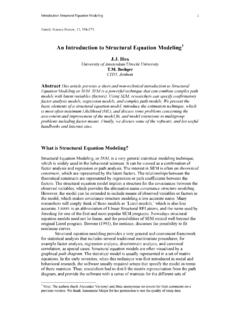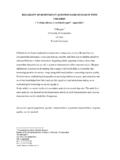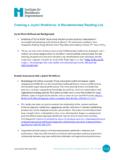Transcription of The Multilevel Generalized Linear Model for …
1 1 7 The Multilevel Generalized Linear Model for categorical and Count Data When outcome variables are severely non-normal, the usual remedy is to try to normalize the data using a non- Linear transformation, to use robust estimation methods, or a combination of these (see Chapter Four for details). Then again, just like dichotomous outcomes, some types of data will always violate the normality assumption. Examples are ordered (ordinal) and unordered (nominal) categorical data, which have a uniform distribution, or counts of rare events. These outcomes can sometimes also be transformed, but they are preferably analyzed in a more principled manner, using the Generalized Linear Model introduced in Chapter Six.
2 This chapter describes the use of the Generalized Linear Model for ordered categorical data and for count data. ORDERED categorical DATA There is a long tradition, especially in the social sciences, of treating ordered categorical data as if they were continuous and measured on an interval scale. A prime example is the analysis of Likert scale survey data, where responses are collected on ordered response categories, for example ranging from 1=totally disagree to 5=totally agree. Another example is a physician s prognosis for a patient categorized as good , fair and bad . The consequences of treating ordered categorical data as continuous are well known, both through analytical work (Olsson, 1979) and simulations ( , Dolan, 1994; Muth n & Kaplan, 1985).
3 The general conclusion is that if there are at least five categories, and the observations have a symmetric distribution, the bias introduced by treating categorical data as continuous is small (Bollen & Barb, 1981). With seven or more categories, the bias is very small. If there are four or fewer categories, or the distribution is skewed, both the parameters and their standard error tend to have a downward bias. When this is the case, a statistical method designed for ordered data is needed. Such models are discussed by, , McCullagh and Nelder (1989) and Long (1997). Multilevel extensions of these models are discussed by Goldstein (1995, 2003), Raudenbush & Bryk (2002), and Hedeker and Gibbons (1994).
4 This chapter treats the cumulative regression Model , which is frequently used in practice; see Hedeker (2008) for a discussion of other Multilevel models for ordered data. Cumulative Regression Models for Ordered Data A useful Model for ordered categorical data is the cumulative ordered logit or probit Model . It is common to start by assigning simple consecutive values to the ordered categories, such as or For example, for a response variable Y with three categories such as never , sometimes and always we have three response probabilities: ()()()123 Prob1 Prob2 Prob3 YpYpYp====== The cumulative probabilities are given by categorical and Count Data 2 *11*212*21231ppppppppp==+=++= where p3 is redundant.
5 With C categories, only C-1 cumulative probabilities are needed. Since p1 and p2 are probabilities, Generalized Linear regression can be used to Model the cumulative probabilities. As stated in chapter Six, a Generalized Linear regression Model consists of three components: 1. an outcome variable y with a specific error distribution that has mean and variance 2, 2. a Linear additive regression equation that produces a predictor of the outcome variable y, 3. a link function that links the expected values of the outcome variable y to the predicted values for : =f( ). For a logistic regression we have the logit link function ()**logitlog1ccccppp == , ( ) and for probit regression the inverse normal link ()1*ccp = , ( ) for c= Assume we specify an intercept-only Model for the cumulative probabilities, written as icc =.
6 ( ) Equation specifies a different intercept c for each of the estimated probabilities. These intercepts are called thresholds, because they specify the link between the latent variable and the observed categorical outcome. The position on the latent variable determines which categorical response is observed. Specifically, 1, if i 1 yi = 2, if 1 < i 2 3, if 2 < i, where yi is the observed categorical variable, i is the latent continuous variable, and 1 and 2 are the thresholds. Note that a dichotomous variable only has one threshold, which becomes the intercept in a regression equation.
7 Figure illustrates the relations between the thresholds , the unobserved response variable , and the observed responses. Multilevel Analysis: Techniques and Applications 3 Figure Thresholds and observed responses for logit and probit Model . The Model in is often called a proportional odds Model because it is assumed that the effect of predictor variables in the regression is that the entire structure is shifted. This implies that the predictors have the same effect on the odds for each category c. The assumption of proportional odds is equivalent to the assumption of parallel regression lines; when the structure is shifted the slope of the regression lines do not change.
8 This assumption is also made in the probit Model . An informal test of the assumption of parallel regression lines is made by transforming the ordered categorical variable into a set of dummy variables, following the cumulative probability structure. Thus, for an outcome variable with C categories, C-1 dummies are created. The first dummy variable equals 1 if the response is in category 1, and 0 otherwise. The second dummy variable equals 1 if the response is in category 2 or 1, and 0 otherwise. And so on until the last dummy variable which equals 1 if the response is in category C-1 or lower, and 0 of the response is in category C.
9 Finally, independent regressions are carried out on all dummies, and the null-hypothesis of equal regression coefficients is informally assessed by inspecting the estimated regression coefficients and their standard errors. Long (1997) gives and example of this procedure and describes a number of formal statistical tests. Cumulative Multilevel Regression Models for Ordered Data Just as in Multilevel Generalized Linear models for dichotomous data, the Linear regression Model is constructed on the underlying logit or probit scale. Both have a mean of zero, the variance of the logistic distribution is 2/3 (standard deviation ), and the standard normal distribution for the probit has a variance of 1.
10 As a consequence, there is no lowest level error term eij, similar to its absence in Generalized Linear models for dichotomous data. In fact, dichotomous data can be viewed as ordered data with only two categories. The results for the logit and the probit formulation are generally very similar, but due to the larger variance on the logit scale both the regression coefficients and their standard errors tend to be approximately times larger on that scale (cf. Gelman & Hill, 2007). Assuming individuals I nested in groups j, and distinguishing between the different cumulative proportions, we write the Model for the lowest level as fo llows: 111221ijjjijijjjijXX =+=+, ( ) categorical and Count Data 4 where the thresholds 1 and 2 are the intercepts for the two response outcomes.





